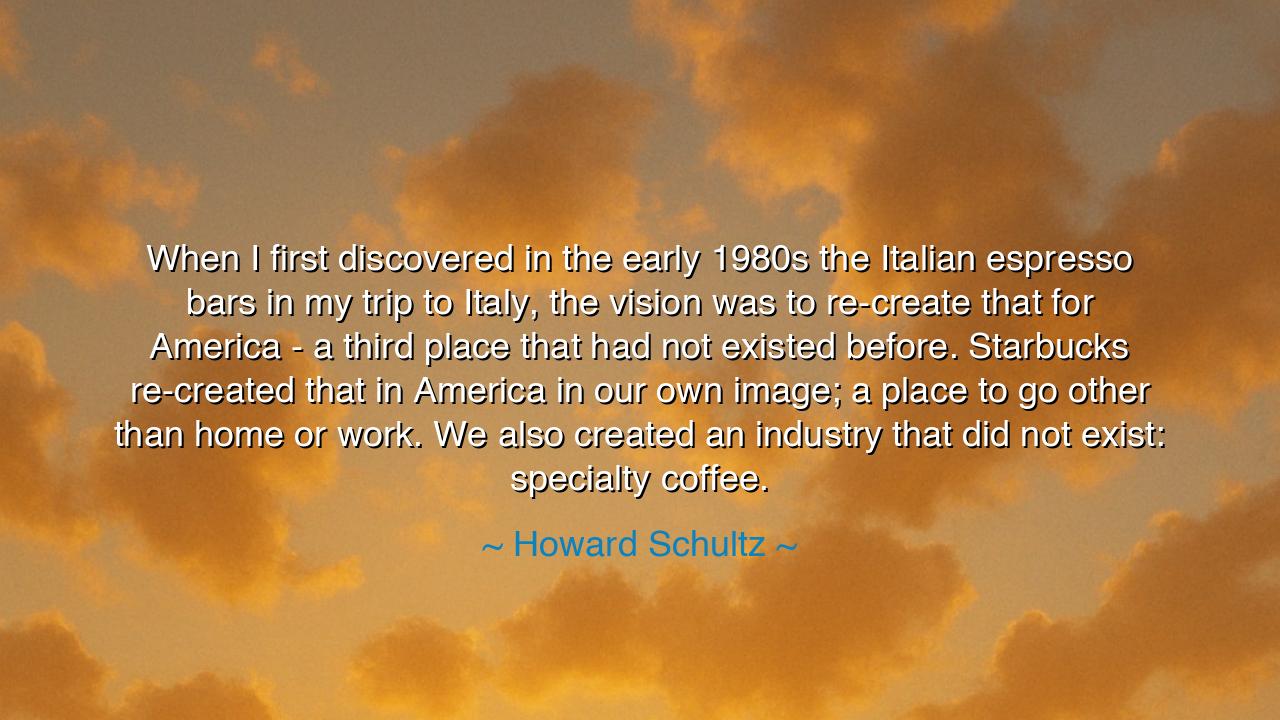
When I first discovered in the early 1980s the Italian espresso
When I first discovered in the early 1980s the Italian espresso bars in my trip to Italy, the vision was to re-create that for America - a third place that had not existed before. Starbucks re-created that in America in our own image; a place to go other than home or work. We also created an industry that did not exist: specialty coffee.






In the testament of Howard Schultz—“When I first discovered in the early 1980s the Italian espresso bars on my trip to Italy, the vision was to re-create that for America—a third place that had not existed before. Starbucks re-created that in America in our own image; a place to go other than home or work. We also created an industry that did not exist: specialty coffee.”—we hear the pilgrim’s vow: to carry fire from one hearth to another and make it native to new soil. He names a passage every builder must walk: behold, translate, and found. Not mimicry, but metamorphosis; not import, but incarnation. The cup becomes a chalice; the counter, an altar of daily fellowship; the steam, a small weather that warms strangers into neighbors.
The ancients would have understood this third place. Between oikos and agora—between home and work—they tended stoas and baths, courtyards and colonnades where discourse could ripen without the clang of hammers or the hush of bedrooms. Schultz, standing in the scent of an Italian espresso bar, recognized an old civic need wearing new fragrance: a room where time slows enough for thought to meet company. His vision was not merely to sell a drink, but to restore a missing chamber in the common house of a nation.
There is a lineage to this labor. In seventeenth-century London, coffeehouses were called “penny universities”: for a coin and a cup, one might earn a lecture on trade, a quarrel on poetry, a plot for a voyage. In Vienna, the café became a parliament of small tables where empires ended and ideas began. Earlier still, in Ottoman streets, the kahvehane stitched together merchants and mystics. Schultz’s specialty coffee took its seat at this table of history, grafting Italy’s bar to America’s boulevard—foam and conversation, ritual and retail, tuned to the rhythms of a different shore.
Mark the craft within the claim: “in our own image.” To re-create is to translate soul, not syllable. The standing bar where locals shout orders becomes a carpeted queue where travelers read names on cups; the lightning espressi of Milan become lingering lattés under soft light. Some will lament the loss of the original accent; others will bless the birth of a dialect that makes outsiders into regulars. This is the high art of adaptation: to honor the seed while altering the soil, that the plant may live and bear fruit where winter speaks another language.
Yet the sentence carries a sterner music: “We also created an industry that did not exist.” Here is the builder’s audacity—naming a market into being, yoking farms on distant hills to a morning ritual in a rushing city, persuading a people that a cup can be both commodity and ceremony. Such creation is never neutral. It can dignify labor by paying for excellence; it can also tempt into excess. The wise founder learns to place guardrails on his own harvest, lest abundance unhouse the virtues that birthed it.
From this story, a clear lesson for those who would found their own third place—in food, in craft, in code, in care. First, go as a student: sit in rooms that move you to silence and write down what your body felt—light, pace, welcome, sound. Second, return as a translator: keep the essence, change the vessels. Third, bind your ritual to justice: trace your supply back to hands and make sure those hands can flourish. Fourth, build for conversation, not only consumption: tables that invite, acoustics that soften, design that says, “stay a while.”
Finally, receive this counsel as a charge: every city is thirsty for rooms that teach us how to be human together. Whether you craft specialty coffee or quiet libraries, community clinics or maker spaces, aim to open doors between home and work where souls can breathe. Let your vision be both ancient and new—rooted in what has always made people whole, yet shaped “in our own image” so that neighbors recognize themselves within it. Then your work, like the Italian espresso bars reborn on American corners, will be more than enterprise; it will be hospitality made visible, a daily liturgy of welcome served hot.






AAdministratorAdministrator
Welcome, honored guests. Please leave a comment, we will respond soon